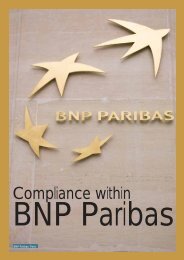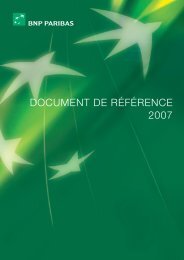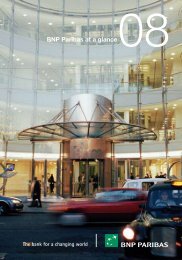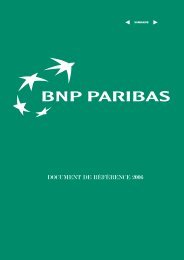2007 REGISTRATION DOCUMENT
2007 REGISTRATION DOCUMENT
2007 REGISTRATION DOCUMENT
- No tags were found...
Create successful ePaper yourself
Turn your PDF publications into a flip-book with our unique Google optimized e-Paper software.
RISK MANAGEMENTRisk factors 3< Contents >3.1 Risk factors1RISK C ATEGORIESRisk categories evolve over time in line with methodological developmentsand regulatory requirements.CREDIT AND COUNTERPARTY RISKCredit risk is the risk of incurring an economic loss on loans andreceivables, existing or potential due to prior commitments resulting fromthe credit quality migration of the Bank’s debtors, which may ultimatelyresult in default. The probability of default and the expected recoveryon the loan or receivable in the event of default are key components ofthe credit quality assessment.Credit risk is measured at portfolio level, taking into account correlationsbetween the values of the loans and receivables making up theportfolio .Credit risk arises in relation to lending operations as well as market,investment and/or payment transactions that potentially expose theBank to the risk of default by the counterparty.Counterparty risk is the risk that the other party in a derivativetransaction will default. The amount of this risk may vary over time inline with market parameters that impact the value of the underlyingmarket instrument .MARKET RISKMarket risk is the risk of incurring an economic loss on financialinstruments carried in the Bank’s balance sheet as a result of adversechanges in market parameters.Market parameters may be observable, such as exchange rates, interestrates, equity or commodity prices, prices for listed derivatives or pricesfor other assets such as cars or real estate. In other cases (credit spreads,implied volatility, implied correlation) they can be directly inferred fromobservable parameters.A number of parameters may not be observable but based on statisticalor empirical analyses.Liquidity is an important component of market risk. In instances oflimited or no liquidity, goods or instruments may not be tradable attheir estimated value. This may arise, for example, due to low transactionvolumes, legal restrictions or a one-way market.Market risk primarily arises in financial instrument trading books, butmay also exist in other portfolios containing assets held in connectionwith the banking business, such as:■ equity holdings;■ properties held for sale;■ cars to be leased, due to fluctuations in the residual value of the assetsupon expiry of the lease.OPERATIONAL RISKOperational risk corresponds to the risk of incurring an economic lossdue to inadequate or failed internal processes, or due to external events,whether deliberate, accidental or natural occurrences. Management ofoperational risk is based on an analysis of the “cause – event – effect”chain.Internal processes giving rise to operational risk may involve employeesand/or IT systems. External events include, but are not limited to floods,fire, earthquakes and terrorist attacks. Credit or market events such asdefault or fluctuations in value do not fall within the scope of operationalrisk.Operational risk generally encompasses legal risks, tax risks, informationsystem risks and the financial implications resulting from reputation andcompliance risks. Due to its importance and link with reputation risk, theBank addresses compliance risk separately from operational risk.Compliance and reputation risksAccording to French regulations, compliance risk is the risk of legal,administrative or disciplinary sanctions, together with the financialloss that a bank may suffer as a result of its failure to comply with allthe laws, regulations, codes of conduct and standards of good practiceapplicable to banking and financial activities (including instructions givenby an executive body, particularly in application of guidelines issued bya supervisory body).By definition, this risk is a sub-category of operational risk. However,as certain implications of compliance risk involve more than a purelyfinancial loss and may actually damage the institution’s reputation, theBank treats compliance risk separately.Reputation risk corresponds to the risk of damaging the trust placedin a corporation by its customers, counterparties, suppliers, employees,shareholders, regulators and any other stakeholder whose trust is anessential condition for the corporation to carry out its day-to-dayoperations.ASSET-LIABILITY MANAGEMENT RISKAsset-liability risk management is the risk of incurring an economic lossas a result of mismatches in interest rates, maturities or nature betweenassets and liabilities. For banking activities, asset-liability managementrisk arises in non-trading portfolios and primarily relates to global interestrate risk. For insurance activities, it also includes the risk of changes inthe value of shares and other assets (particularly property) held by thegeneral insurance fund.234567891011<strong>2007</strong> Registration document - BNP PARIBAS 69
















